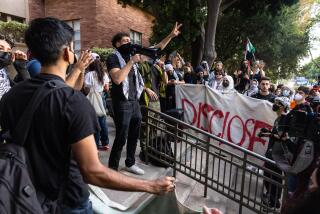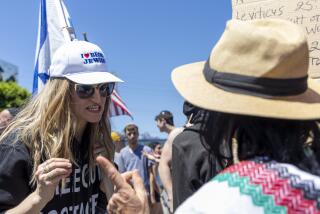American emigre, devoted to peace, dies after Palestinian attack in Israel
Reporting from Jerusalem — An American educator who marched for civil rights in the 1960s and advocated coexistence between Muslims and Jews when he moved to Israel has died of wounds sustained in a Palestinian attack on a bus in Jerusalem two weeks ago, officials said.
It was one of many attacks in a month of violence triggered in part over Palestinian allegations of Israel changing longstanding agreements at Jerusalem’s most sensitive holy site, charges Israel has strongly denied and said amount to incitement to violence.
In an effort to lower tensions at the site, Israeli and Jordanian officials said Tuesday that new surveillance cameras should be installed within days at the shrine, with the goal of streaming footage live online for maximum transparency. Jordan serves as the custodian of the Muslim-administered site.
Richard Lakin, 76, died Tuesday of wounds sustained on Oct. 13 when two Palestinian men boarded a bus in Jerusalem and began shooting and stabbing passengers. It was one of the bloodiest attacks in recent violence in which Palestinian attackers killed 11 Israelis. In that time, at least 55 Palestinians have been killed, including 35 identified by Israel as attackers and the rest in clashes with security forces.
In the most recent such case, the Israeli military said its forces shot a Palestinian man Wednesday after he allegedly tried to stab a soldier in the West Bank city of Hebron. The dead man was not immediately identified.
Lakin was originally from Newton, Mass., and a longtime school administrator in Glastonbury, Conn. His Facebook page displayed an image of Israeli and Arab kids hugging under the word “coexist.”
Micah Avni said his father was a beloved educator and author of a book on teaching. He was an elementary school principal in the U.S. and taught English in mixed classes of Muslims and Jews in Jerusalem after moving to Israel in 1984.
In the 1960s, Lakin was active in the civil rights movement in the U.S., marching with the Rev. Martin Luther King Jr. and bringing students from Boston to the South for sit-ins, Avni said.
“He was a big believer in people and in peace and in being kind and he never hurt a soul in his life,” Avni said, adding that thousands of people from around the world have contacted him to express their shock and condolences after his father’s death.
Rabbi Richard Plavin of Beth Shalom B’nai Israel in Manchester, Conn., which Lakin attended before moving to Israel, said Lakin was a passionate man who pursued peace and justice. He said Lakin was a Freedom Rider in the 1960s, working to desegregate the South.
“He was really a peacenik. He believed deeply in a two-state solution and wanted to see Arabs and Jews living together in peace,” he said.
Lakin was on the bus returning from a doctor’s appointment when he was shot and stabbed by two Arabs from East Jerusalem, his son said.
The current round of violence began in mid-September, triggered in part by heated disputes over the Jerusalem shrine.
The hilltop compound in Jerusalem’s Old City is revered by Jews as the Temple Mount, site of the two Jewish biblical Temples. It is the holiest site in Judaism. Known to Muslims as the Noble Sanctuary, it houses the Al-Aqsa Mosque and the gold-topped Dome of the Rock. It is the third-holiest site in Islam after Mecca and Medina in Saudi Arabia.
Under decades-old arrangements, Jews are allowed to visit, but not to pray at the shrine.
The number of Jewish visitors to the site has risen in the past five years, while several leading Israeli politicians and groups have made statements demanding prayers at the site.
Such comments have fueled Palestinian fears that Israel is trying to expand its presence at the site. Israel has adamantly denied the allegations and accused Palestinian leaders of inciting violence and spreading lies.
In mid-September, tensions started to soar. Clashes erupted at the shrine between young Palestinian throwing stones and fire bombs and Israeli security forces. The violence quickly spread to the rest of Jerusalem, as well as the West Bank and Gaza Strip.
The idea to install the cameras emerged during separate talks late last week between U.S. Secretary of State John F. Kerry and the three sides with a stake at the shrine — Israel, Jordan and the Palestinian self-rule government. Kerry was looking for a way to lower tensions, but it’s not clear if video cameras will suffice.
Under the compromise brokered by Kerry, video cameras are to be installed inside the 37-acre walled platform to allow continuous monitoring with the aim of defusing tensions.
Israeli officials confirmed the plan, and in a statement, Prime Minister Benjamin Netanyahu’s office said it hopes to start the process “as soon as possible.”
Israel has welcomed the plan, saying the cameras will prove it is doing nothing wrong and expose violent activities by Palestinian protesters.
The Palestinians have given the plan a cold reception, saying Israel will use the cameras to arrest people and complaining that deeper issues have been ignored.
More to Read
Sign up for Essential California
The most important California stories and recommendations in your inbox every morning.
You may occasionally receive promotional content from the Los Angeles Times.










